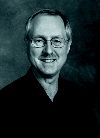
"The ability to make images of light elements such as carbon, nitrogen, and oxygen in solids at atomic resolution is a very big step forward—and it was achieved by a technique that can be a routine tool in the future. It is of great interest to science and industry," says Christian Kisielowski, who with Michael O� Keefe and their colleagues Christian Nelson, Chengyu Song, and Roar Kilaas of Berkeley Lab�s Materials Sciences Division achieved the O�M �s record-breaking results.
Less than a decade ago the world�s most powerful transmission electron microscope was NCEM�s three-story, million-volt Atomic Resolution Microscope, with practical direct resolution of 1.6 angstroms (though Kisielowski once managed to squeeze out 1.54 angstroms). Then a Japanese-built, 1.25-million-volt machine in Germany achieved 0.95-angstrom resolution—but at a cost of more than 10 million Deutschmarks. Researchers around the world recognized the need for higher resolution at reasonable cost.
In transmission electron microscopy a focused beam of electrons is directed through a thin sample, whose image is constructed from the interference patterns of the scattered electrons. Resolution, as traditionally defined, is restricted to object elements that can be distinguished when all the image components are in phase.
A microscope can actually produce much more information, however, although the phases may be scrambled. The effect of misphasing is to weaken or even reverse the contrast of closely spaced features, which changes the apparent position of the atoms.
However, "a microscope can be designed so that its �information limit�— the limit to which it produces phase-scrambled information—lies well beyond its traditionally defined nominal resolution," explains NCEM�s Michael O�Keefe.
In 1990 O�Keefe, working with scientists from Berkeley Lab�s Life
Sciences Division and the Department of Earth and Planetary Science at the
University of California at Berkeley,� showed that the Atomic Resolution
Microscope could go beyond its direct resolution of 1.6 angstroms and, by
using computer processing to combine images taken at several focus values,
achieve a resolution of 1.38 angstroms.
![]()

![]()
MICHAEL
O�KEEFE
CHRISTIAN
KISIELOWSKI

"I
was inspired to do science by watching satellites from
the front oval—that�s cricket, you know," Michael
O�Keefe says of his schooldays in Australia. "It�s a wonder
I�m not working for NASA." After working toward his 1975
Ph.D. from the University of Melbourne, inner space captured
his imagination. Following stints at Arizona State and
Cambridge�s Cavendish Laboratory, he joined NCEM in 1983.
Christian Kisielowski earned his doctorate from the University
of Cologne, Germany, in 1985 and began his career investigating
semiconductors. In the 1990s, at Bell Labs, he developed
electron microscopy techniques based on analyzing lattice
images. At UC Berkeley, as head of the gallium nitride
group, he pursued both solid state physics and microscopy
before joining NCEM in 1998.
"An image with resolution out to the �information limit� can be constructed by making a through-focal series of images of the sample, each with the scattered electrons interfering at different relative phases," says O�Keefe, who proposed that NCEM could penetrate the one-angstrom barrier with a microscope designed to employ focal-series reconstruction.�
When this approach was first suggested in the �60s, it wasn�t practical. Through-focus methods depend upon beams with all electrons at nearly the same energy, and not until the early 1990s did beam sources become stable enough for medium-voltage instruments to operate reliably.
In 1993 NCEM secured the funds to acquire a suitable instrument, a Philips CM300. Researchers working in the European Commission�s BRITE-EURAM program had set out to build a new generation of high-resolution, medium-voltage electron microscopes and invited NCEM to be a partner in the project, based on NCEM�s high-resolution expertise, including O�Keefe�s theoretical work on computer-processing series of images.
Although the standard CM300�s resolution limit was 1.7 angstroms and its information limit was 1.05 angstroms, O�Keefe laid out improved specifications that would bring the information limit well below 1.0 angstrom; in this way, using focal-series reconstruction to correct the phases of image components beyond the direct resolution, he planned to achieve resolution significantly better than 1 angstrom.
Results confirm the O�M �s capacity to produce phase-scrambled information far beyond 1.7 angstroms and turn it into higher resolution.
"In the case of gallium nitride, we made 20 different images, each with the scattered electrons interfering with different relative phases," says Christian Kisielowski. The computer unscrambles the electron waves and combines them into a single high-resolution image with all waves in phase. "It�s a way of going from the complexity of the lattice images produced by the O�M to the simplicity of crystalline structures."
Computer processing of focal-series images has allowed the O�M to reconstruct images with resolutions near its information limit. With diamond, Kisielowski and O� Keefe, working with Y.C. Wang, showed that the information limit extends to at least 0.89 angstrom. In January 2000, Kisielowski recorded an undistorted silicon lattice image, which with its Fourier transform suggests that the microscope�s resolution is 0.78 angstrom or better.
Because the O�M can only produce ultra-high resolution with samples less than a hundred angstroms thick, the Atomic Resolution Microscope, NCEM�s "grandfather," is far from being outmoded by its diminutive descendant. The ARM achieves superb resolution with thicker samples; it can perform dynamic experiments, and it allows for larger tilt angles than the O�M.
For its ultrahigh resolution the O�M stands as an achievement—but also as a challenge.
Says Kisielowski, "We�re aiming to investigate materials with even shorter bond lengths with the present information limit. We want to have procedures in place that work reliably and fast to make the experiments available to our user community as soon as possible. Colleagues from other laboratories have already started to share our excitement by investigating their own samples with the O�M."
Uli Dahmen, head of NCEM, is equally enthusiastic. "The one-angstrom barrier has been a Holy Grail for electron microscopists worldwide. The O�M makes a truly extraordinary addition to Berkeley Lab�s scientific �toolbox,� and I can�t wait to see what new discoveries it will bring for our users." — Paul Preuss �
|
Next > | |||